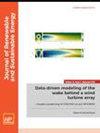Analysis of the characteristics and influencing factors of China's embodied energy flow network
IF 1.9
4区 工程技术
Q4 ENERGY & FUELS
引用次数: 0
Abstract
Understanding the flow of embodied energy between provinces in China and the factors affecting the network has an important impact on reducing energy consumption in each province and promoting balanced regional development. This paper uses the multi-regional input–output model to construct the interprovincial embodied energy flow network in China and defines the energy flow between provinces under the trade of products and services. Then, it uses the ecological network model to carry out the ascendency and network environ analysis of the interprovincial embodied energy flow network in China and uses the Quadratic Assignment Procedure regression model to calculate the impact of various factors on the flow network. The main research conclusions are as follows: (1) The embodied energy flow in the middle reaches of the Yangtze River and the Yellow River is relatively high. The embodied energy flow value in Ningxia and Qinghai is low. Zhejiang, Guangdong, and Jiangsu often have the highest embodied energy outflow value, while Inner Mongolia, Shanxi, and other provinces have higher inflows. (2) The center of gravity of through flow in the flow system is biased to Jiangsu, Guangdong, and other places; Gansu, Ningxia, Qinghai, and Hainan are at the edge of the system. (3) The differences in the economic development level, population size, and energy structure have a positive impact on the embodied energy flow network between provinces in China; the geographic distance will have a negative impact on the flow network.中国蕴含能流网络特征及影响因素分析
了解中国省际蕴含能流动及其影响因素,对降低各省能耗、促进区域均衡发展具有重要意义。本文运用多区域投入产出模型构建了中国省际蕴含能量流网络,并对产品和服务贸易下省际蕴含能量流进行了界定。然后,利用生态网络模型对中国省际具能流网络进行优势分析和网络环境分析,并利用二次分配程序回归模型计算各因素对流网络的影响。主要研究结论如下:(1)长江中游和黄河中游的蕴含能流量较高。宁夏和青海的蕴含能流值较低。浙江、广东和江苏往往具有最高的隐含能量流出值,而内蒙古、山西等省份具有更高的流入值。(2)流动系统直通流重心偏向江苏、广东等地;甘肃、宁夏、青海和海南处于该系统的边缘。(3)经济发展水平、人口规模和能源结构的差异对省际蕴含能流网络具有正向影响;地理距离会对流动网络产生负面影响。
本文章由计算机程序翻译,如有差异,请以英文原文为准。
求助全文
约1分钟内获得全文
求助全文
来源期刊

Journal of Renewable and Sustainable Energy
ENERGY & FUELS-ENERGY & FUELS
CiteScore
4.30
自引率
12.00%
发文量
122
审稿时长
4.2 months
期刊介绍:
The Journal of Renewable and Sustainable Energy (JRSE) is an interdisciplinary, peer-reviewed journal covering all areas of renewable and sustainable energy relevant to the physical science and engineering communities. The interdisciplinary approach of the publication ensures that the editors draw from researchers worldwide in a diverse range of fields.
Topics covered include:
Renewable energy economics and policy
Renewable energy resource assessment
Solar energy: photovoltaics, solar thermal energy, solar energy for fuels
Wind energy: wind farms, rotors and blades, on- and offshore wind conditions, aerodynamics, fluid dynamics
Bioenergy: biofuels, biomass conversion, artificial photosynthesis
Distributed energy generation: rooftop PV, distributed fuel cells, distributed wind, micro-hydrogen power generation
Power distribution & systems modeling: power electronics and controls, smart grid
Energy efficient buildings: smart windows, PV, wind, power management
Energy conversion: flexoelectric, piezoelectric, thermoelectric, other technologies
Energy storage: batteries, supercapacitors, hydrogen storage, other fuels
Fuel cells: proton exchange membrane cells, solid oxide cells, hybrid fuel cells, other
Marine and hydroelectric energy: dams, tides, waves, other
Transportation: alternative vehicle technologies, plug-in technologies, other
Geothermal energy
 求助内容:
求助内容: 应助结果提醒方式:
应助结果提醒方式:


